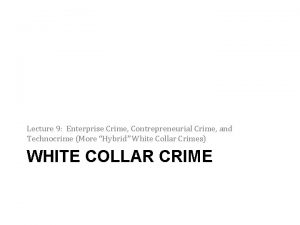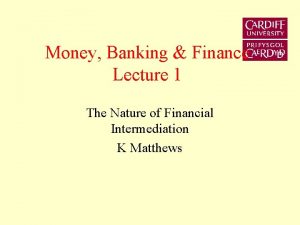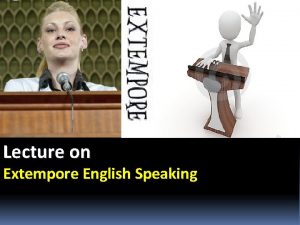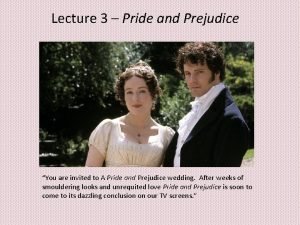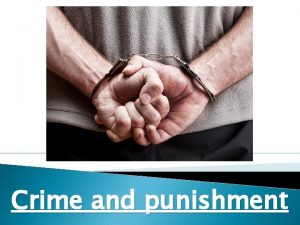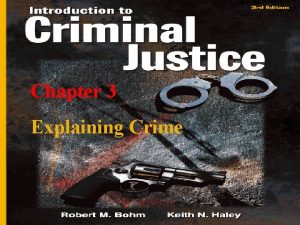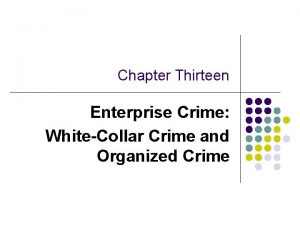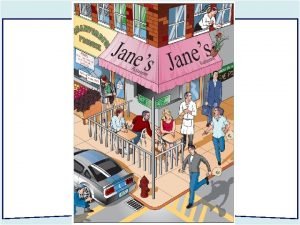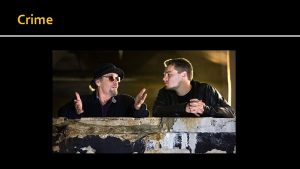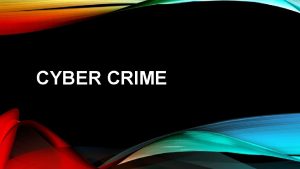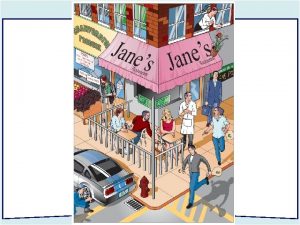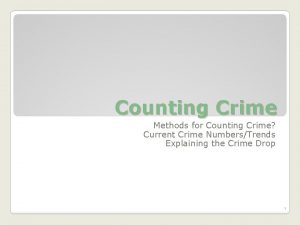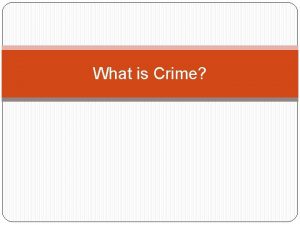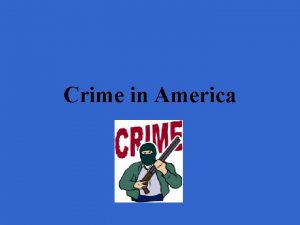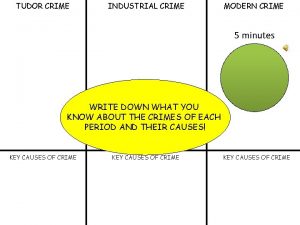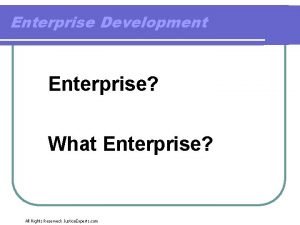Lecture 9 Enterprise Crime Contrepreneurial Crime and Technocrime




















- Slides: 20

Lecture 9: Enterprise Crime, Contrepreneurial Crime, and Technocrime (More “Hybrid” White Collar Crimes) WHITE COLLAR CRIME

Hybrids of: (1) White Collar Crime, and (2) Enterprise Crime or Contrepreneurial Crime or Technocrime

Enterprise Crime • Refers to the interrelated dealings of legitimate businesspeople, political officials, and syndicated racketeers. • Most common example: the Mafia

Substantive RICO Provisions • What constitutes a RICO violation? o In plain English, section 1962(a) generally makes it unlawful for a person to use an enterprise to launder money generated by a pattern of racketeering activity.

o Section 1962(b) makes it unlawful for a person to acquire or maintain an interest in an enterprise through a pattern of racketeering activity. Ex. : A stereotypical violation of section 1962(b) occurs when a victim business owner cannot make payments to a loan shark. Upon default, the loan shark says: "you're either going to die or you're going to give me your business. "

Given the threat to this life, the victim transfers control of his business to the loan shark. Usually, the victim business owner remains the owner on paper but the loan shark controls the business and receives all income from the business. Thus, the loan shark has acquired and maintained interest or control over an enterprise (i. e. the business) through a pattern of racketeering activity (i. e. , loan sharking and extortion).

o Section 1962(c) prohibits any defendant person from operating or managing an enterprise through a pattern of racketeering activity. o Section 1962(d) makes it unlawful for a person to conspire to violate subsections (a), (b) or (c) of the RICO Act.

Understanding RICO Although the RICO Act can be used in many contexts, the statute is most easily understood in its intended context: the Mafia. In the context of the Mafia, the defendant person (i. e. , the target of the RICO Act) is the Godfather. The "racketeering activity" is the criminal activities in which the Mafia engages, e. g. , extortion, bribery, loan sharking, murder, illegal drug sales, prostitution, etc.

Because the Mafia family has engaged in these criminal actions for generations, the criminal actions constitute a pattern of racketeering activity. The government can criminally prosecute the Godfather under RICO and send him to jail even if the Godfather has never personally killed, extorted, bribed or engaged in any criminal behavior. The Godfather can be imprisoned because he operated and managed a criminal enterprise that engaged in such acts.

Moreover, under section 1964(c) of the RICO Act, the victims of the Mafia family (i. e. , the extorted businessman, the employers whose employees were bribed, debtors of the loan shark, the family of a murder victim) can sue the Godfather civilly and recover the economic losses they sustained by reason of the Mafia family's pattern of racketeering. As a practical matter, the closer a plaintiff's case is to the Mafia scenario described above, the better chance the plaintiff has in succeeding under the RICO Act.

Contrepreneurial Crime • E. g. , professional criminals, career criminals • Examples: o “Get-rich-quick” schemes o Land swindles o Ponzi and Pyramid schemes

The Ponzi Scheme Carlos Ponzi

In approximately 1918, Carlos Ponzi discovered that he could exchange an International Postal Reply Coupon (IRC) issued in one country for stamps to cover the cost of postage in the country of redemption. If the values were different, there was a potential profit. For instance, an IRC could be cheaply purchased in Italy and exchanged for U. S. postage stamps at a higher value. Ponzi would then sell the stamps, collecting a profit on the transaction.

Ponzi convinced friends and associates to invest in his scheme and promised a 50% return on investments in 45 days or “double your money” in 90 days. Early investors were then paid large sums as returns, which allowed Ponzi to attract additional investors.

Ponzi started his own company, the Securities Exchange Company, to promote the scheme. Ponzi hired agents and paid them generous commissions for every dollar they brought in. By February 1920, Ponzi's total take was $5, 000 USD, a large sum for the time. By March 1920, he had made $30, 000. By May 1920, he had made $420, 000. By July 1920, he had made millions.

Ponzi was bringing in cash at a fantastic rate, but the simplest financial analysis would have shown that the operation was running at a large loss. As long as money kept flowing in, existing investors could be paid with the new money, but colossal liabilities were accumulating.

On July 26, 1920 the Boston Post started a series of articles that asked hard questions about the operation of Ponzi's money machine. The Post contacted Clarence Barron, the financial analyst who published the Barron's financial paper, to examine Ponzi's scheme. Barron observed that though Ponzi was offering fantastic returns on investments, Ponzi himself wasn't investing with his own company.

Barron then noted that to cover the investments made with the Securities Exchange Company, 160, 000 postal reply coupons would have to be in circulation. However, only about 27, 000 coupons were actually circulating. The United States Post Office stated that postal reply coupons were not being bought in quantity at home or abroad.

The gross profit margin in percent on buying and selling each IRC was colossal. But, the overhead required to handle the purchase and redemption of these items, which were of extremely low cost and sold individually, would have exceeded the gross profit. On November 1, 1920, Ponzi pleaded guilty to mail fraud, and was sentenced to five years in federal prison. He was released after three and a half years to face state charges. He was again found guilty and sentenced to nine years.

Technocrime • A subset of white collar crime in which technology is used to commit illegal activity. • Most common form: computer crime (e. g. , hacking, software piracy, sabotaging programs)
 Technocrime definition
Technocrime definition 01:640:244 lecture notes - lecture 15: plat, idah, farad
01:640:244 lecture notes - lecture 15: plat, idah, farad Contemporary
Contemporary Putting the enterprise into the enterprise system
Putting the enterprise into the enterprise system Enterprise
Enterprise Electricity and magnetism lecture notes
Electricity and magnetism lecture notes Power system dynamics and stability lecture notes
Power system dynamics and stability lecture notes Microbial physiology lecture notes
Microbial physiology lecture notes Ternology
Ternology Cloud computing lecture
Cloud computing lecture 50f7 tolerance
50f7 tolerance Financial institutions and markets lecture notes ppt
Financial institutions and markets lecture notes ppt Banking and finance lecture
Banking and finance lecture Extempore and lecture
Extempore and lecture Utilities and energy lectures
Utilities and energy lectures Pride and prejudice lecture
Pride and prejudice lecture Sensors and actuators ppt
Sensors and actuators ppt Embryotomy ppt
Embryotomy ppt Lecture on love courtship and marriage
Lecture on love courtship and marriage Power system dynamics and stability lecture notes
Power system dynamics and stability lecture notes Project planning and management lecture notes ppt
Project planning and management lecture notes ppt
